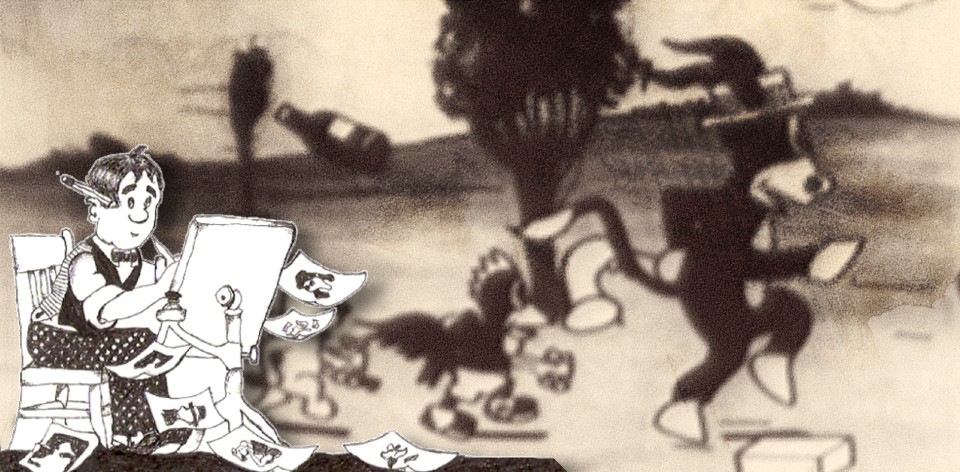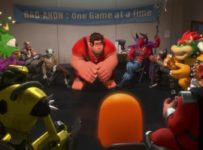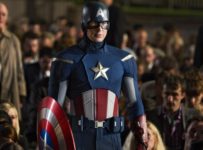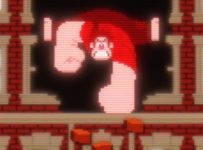Here I attempt to watch (almost) all of Disney’s output in the order it was released. We continue our Dis-covery in 1922, as Walt modernises some classics.
Before the Disney brand became synonymous with global market dominance, it was most associated with fairy tales. Some say the studio updates them for modern palettes, while others would accuse them of the Disneyfication of common legends. Yet whichever way you slice it, fairy tales have been in Disney’s DNA since their inception.
As we saw earlier, Walt Disney’s earliest efforts were closer to test pieces: single-frame setups that they described as ‘illustrated jokes’ and screened at the Newman Theater. “The success of the Newman Laugh-O-Grams,” wrote Robert Tieman, “encouraged Walt to set up his own company.” Ub Iwerks joined him as his chief animator.
Reportedly influenced by animator Paul Terry’s spoofs of Aesop’s fables, Disney and Iwerks started work on animating a series of fairy tales in various modern settings throughout 1922. In RED RIDING HOOD, for example, we have a dramatically different version of the familiar tale, allegedly due to the rights being unavailable at that stage. Of course, it didn’t stop ol’ Walt from lifting a design for Felix the Cat for his recurring character of Julius, seen in the short shooting holes in donuts with a shotgun.
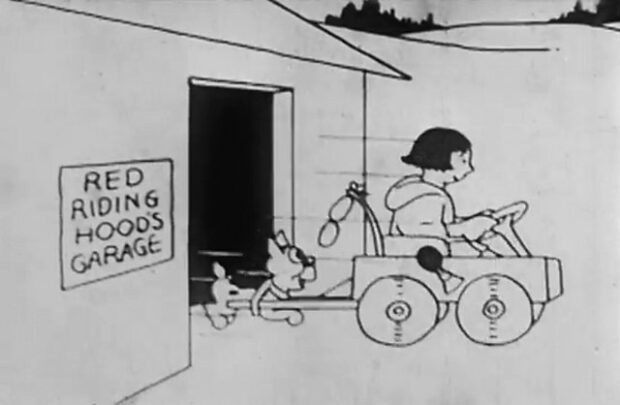
From there, the story diverges further. Red is still seen taking a basket to granny, using her motorised cart instead of skipping through the forest. The ‘wolf’ is (rather disturbingly) just a sleazy older dude in a car, although he does have the ability to shrink said car for safekeeping. It does mark the triumphant return of the Fliver, quite possibly the same one we’d seen flying over Kansas City a year earlier. Instead of a woodsman, we have a fellow in a plane.
All of the Laugh-O-Grams shorts follow a similar model. While most of this is an exercise in repetitive motion and early animation workshopping, achieved by photographing inked lines on paper rather than animation cels, they could be hailed as Disney’s first attempt at storytelling in animation. This is not to be dismissed. Walt was only 21 when he made the first of these, taking sixth months and working in his off-hours. Not unlike the later Snow White, this may have been regarded as one of his first ‘follies.’
In THE FOUR MUSICIANS OF BREMEN, which biographer Neal Gabler argues is actually the first short produced by the studio, the narrative feels amped up several notches. Disney takes the loosest threads of the classic German tale Die Bremer Stadtmusikanten. Featuring another early appearance of Julius the Cat (modelled after Felix) with a donkey, rooster and dog companions, there’s little trace of the musician story here. It’s more concerned with their extracurricular activities: fishing and fighting criminals.
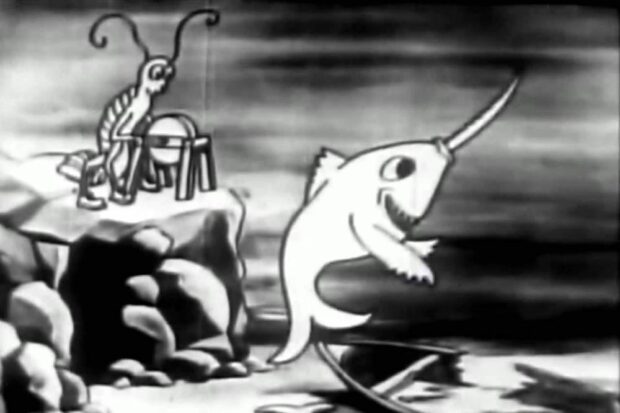
Embracing cartoon logic to its extremes, the animals find themselves pursued by a swordfish across land — with an actual detachable sword on its snout. Oxygen paradoxes notwithstanding, there’s a wonderfully clever moment when the swordfish uses his most prominent feature to saw a tree that the animals have used as temporary refuge.
The showpiece moment is the standoff between a group of criminals, the animals, and an anthropomorphic house. Using simple repetition and rubber-banded objects, it’s a delightfully chaotic few minutes in which the chimney bounces back cannonballs, a house is turned into Swiss cheese, and Julius rides said cannonballs using his tail as a steering column.
Disney would make several attempts to bring this tale to life in later years, and some of this is documented in the excellent Charles Solomon book, The Disney That Never Was. The closest they got was in 1969, before a Russian short was released that year. The only tangible evidence we have of Disney’s later vision is The Story Of The Bremen Town Musicians, released by Disneyland Records in 1970.
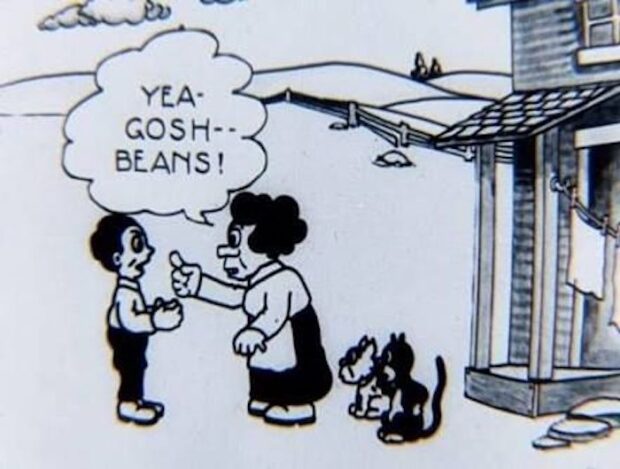
While Jack and the Beanstalk and Goldie Locks and the Three Bears shorts are sadly lost to the ages, we still have JACK THE GIANT KILLER. Later retitled with synchronised sound as The K.O. Kid, this was the last of seven Fairy Tales Laugh-O-Grams directed by Walt Disney. Recently recovered and shown to festival crowds, the set-up is simple enough: the titular Jack, his girlfriend Susie and your ol’ pal Julius the Cat set their sights for the Land of the Giants. Hijinks ensue and there’s a fair bit of chasing.
While not exactly formulaic, at least in the modern definition of the word, Disney was settling into a solid rhythm here. The storm sequence is sublime, revealing a darker side as it rain tridents. It’s as if the King of the Sea himself is attacking them. Our good friend the swordfish makes a welcome return, this time with a more hi-tech buzzsaw on his face.
PUSS IN BOOTS is a far cry from the DreamWorks film a century later, presenting as a loose series of visual gags. It doesn’t make much sense: there’s a monarchy, but it’s clearly the US in the 1920s, and we swing from romance to bullfighting to a cinema so quickly that you’re liable to get whiplash.
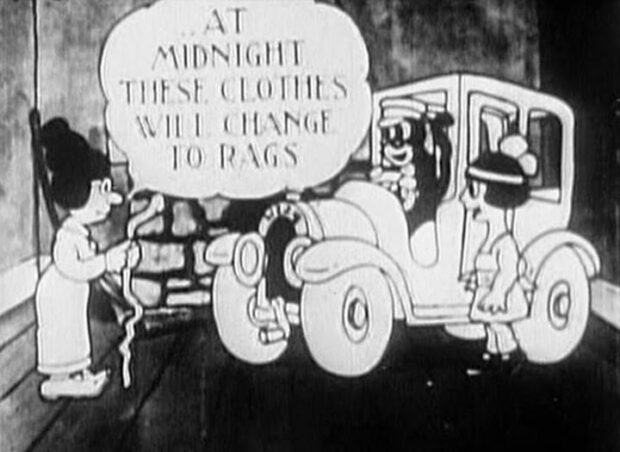
Yet scratch beneath the surface and there’s a lot more going on here. Getting quite meta for fledgling industry, there’s a film-within-a-film starring “Rodolph Vaselino.” There’s the slightly surreal ‘as time flies’ intertitles (complete with flying clocks). There’s an open-ended conclusion with the circle zoom on the speedometer, and even a poster for Disney’s own ‘Laugh-O-Grams Cinderella!
Speaking of which, CINDERELLA — Disney’s first attempt at a story they would later perfect in 1950 — starts with the Prince shooting and hunting bears. (Not a Disney+ classic then). Otherwise this is a straightforward (albeit modernised) adaptation of the fable, and the last of the Laugh-O-Grams that Disney and friends produced prior to starting in on the hybrid Alice Comedies. Like Puss in Boots before it, here we see Disney refining storytelling in the lead-up to longer and more complex pieces of animation.
The story hits most of the same beats as the fairy tale, albeit updated to the 1920s. The carriage is a car, for example, and Cinderella goes to the ball in a flapper outfit. There’s chases and gags aplenty, but it ends rather abruptly with a “happily ever after.” Curiously, so does the later 1950 version. For the keen, there is a short documentary narrated by Don Hahn from one of the DVD releases called The Cinderella that Never Was. It only briefly touches on this film, but it’s interesting to see how this early short developed into the later classic.
Legacy o’ Grams
While not literally seen in frame, as was the case in his earlier shorts, Walt had a heavy hand in these early shorts. The names associated with this early series — Ub Iwerks, Hugh Harman, Friz Freleng, and Carman Maxwell — all went on to be legends in the animation industry.
Like most of their contemporaries, they are still predominantly a collection of short visual gags. They were commercial enterprises, and even included an ad for a dentist (Tommy Tucker’s Tooth). Yet here we see Walt starting to pull those elements together into a story. Yet these fairy tale shorts were considered to be commercial failures. After finishing pre-production on the Alice Comedies, the Laugh-O-Gram studio filed for Chapter 11 bankruptcy in July 1923. We assume things got better for Disney eventually.
Still, this was the beginning of a storytelling motif for the animator, by reworking classics and making them uniquely Disney. Somewhere on a parallel Earth, these often outlandishs bits of animation may have been condemned to the dust bins of history. Indeed, at least one of these shorts lost for decades until it was recovered in the UK in 1998. Yet these early days inspired much of what would come, not least of which was Steamboat Willie only 6 years later, solidifying almost a decade of work on his craft.
NEXT TIME: Enter Alice.

Gabler, N. (2011). Walt Disney: The biography. London: Aurum.
Tieman, R. (2003). The Disney treasures. New York: Disney Editions.
MORE FROM DISNEY MINUS: Newman Laugh-O-Grams | Walt’s first fairy tales | Alice Comedies | Oswald the (Un)lucky Rabbit | Silly Symphonies | The Spirit of 1943 | So Dear to My Heart | One Hour in Wonderland
All images in this article are owned by Disney unless stated otherwise.

